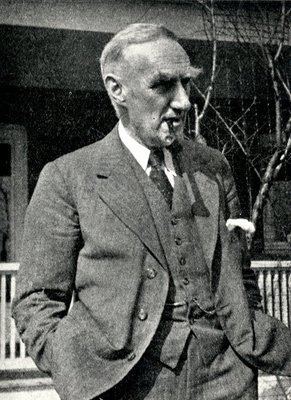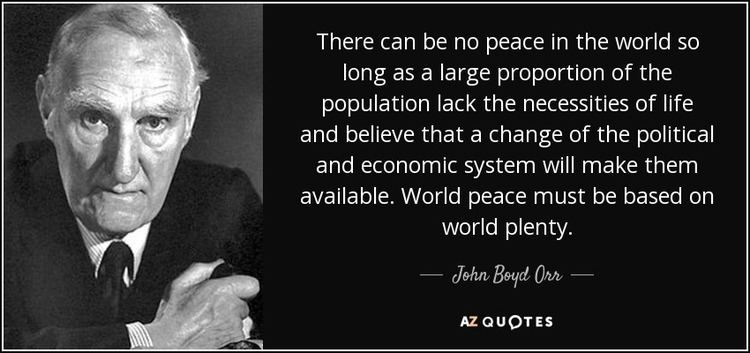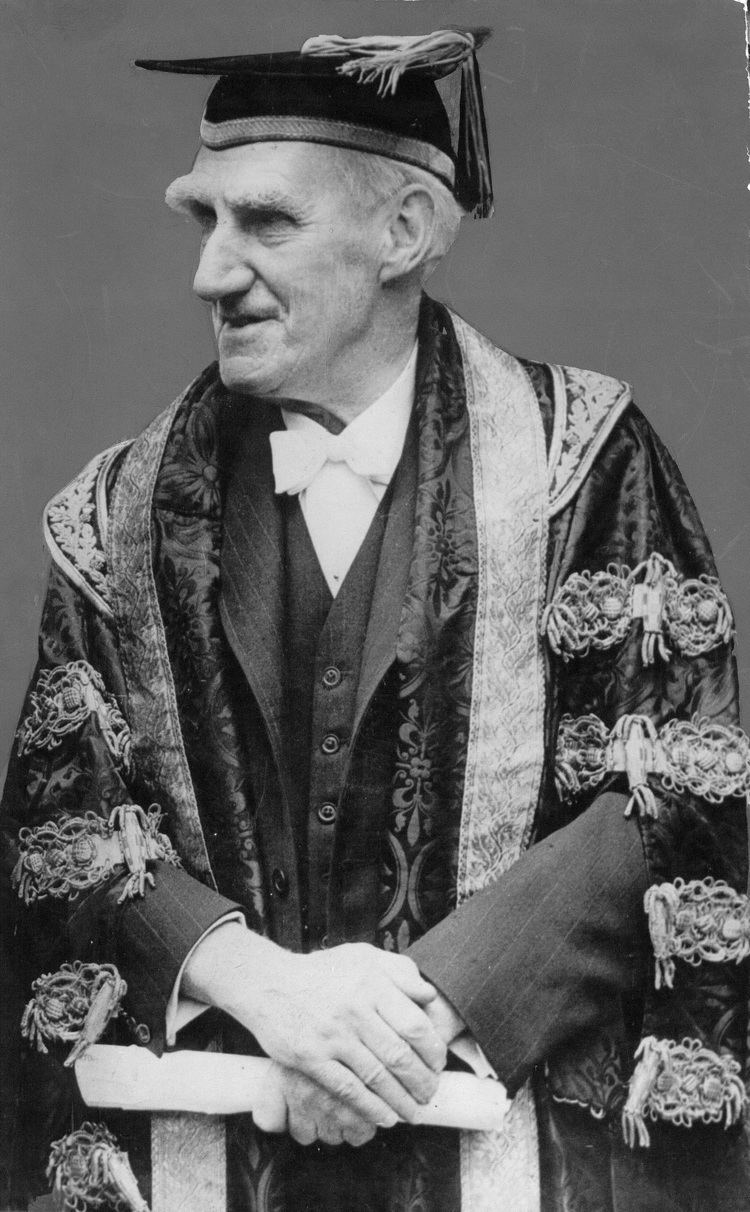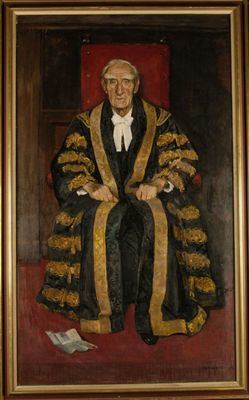Citizenship United Kingdom Known for wartime nutrition Nationality Scottish Name John Orr, | Alma mater University of Glasgow Role Doctor Doctoral advisor E.P. Cathcart | |
 | ||
Born John Boyd Orr
23 September 1880
Kilmaurs, East Ayrshire ( 1880-09-23 ) Institutions University of Glasgow
Rowett Research Institute
Food and Agriculture Organization Died June 25, 1971, Edzell, United Kingdom Books Food Health and Income, The Scotland of Our Sons Education University of Glasgow, Kilmarnock Academy Awards Nobel Peace Prize, Distinguished Service Order, Bellahouston Gold Medal, Rumelhart Prize Fields Biology, Medicine, Nutrition | ||
John Boyd Orr, 1st Baron Boyd-Orr (23 September 1880 – 25 June 1971), known as Sir John Boyd Orr from 1935 to 1949, was a Scottish teacher, doctor, biologist and politician who received the Nobel Peace Prize for his scientific research into nutrition and his work as the first Director-General of the United Nations Food and Agriculture Organization (FAO). He was the co-founder and the first President (1960–1971) of the World Academy of Art and Science (WAAS).
Contents
- Early life and family background
- First encounters with poverty
- Return to university
- Research career
- The beginnings of the Rowett Research Institute
- War service
- Post war expansion of the Rowett Research Institute
- International and political work
- References

Early life and family background

John Boyd Orr was born at Kilmaurs, near Kilmarnock, East Ayrshire, Scotland, the middle child in a family of seven children. His father, Robert Clark Orr, was a quarry owner, and a man of deep religious convictions, being a member of the Free Church of Scotland. His mother, Annie Boyd, was the daughter of another quarry master, wealthier than Robert Orr, and grandmaster of a Freemason's Lodge.

The family home was well supplied with books, and his father was widely read in political, sociological and metaphysical subjects, as well as religion. As he grew older, John would regularly discuss these subjects with his father, brothers, and visiting friends. There was also family worship each evening.

When John was five years old, the family suffered a setback when a ship owned by Robert Orr was lost at sea. They had to sell their home in Kilmaurs, and moved to West Kilbride, a village on the North Ayrshire coast. According to Kay, the new house and environment were a great improvement on Kilmaurs, despite the family's reduced means. The major part of his upbringing took place in and around West Kilbride. He attended the village school until he was thirteen. Religion was then an important part of junior education in Scotland, and the school gave him a good knowledge of the Bible, which stayed with him for the rest of his life.

At the age of thirteen, John won a bursary to Kilmarnock Academy, a significant achievement as such bursaries were then rare. The new school was some 20 miles (32 km) from his home in West Kilbride, but his father owned a quarry about two miles (3 km) from the Academy, and John was provided with accommodation nearby. His family cut short his education at the Academy because he was spending too much time in the company of the quarry workers (where he picked up a "wonderful vocabulary of swear words"), and after four months he returned to the village school in West Kilbride where he continued his education until he was seventeen under the inspirational tutelage of Headmaster John G. Lyons. There he became a pupil teacher at a salary of £10 for the first year, and £20 for the second. This was a particularly demanding time for the young Boyd Orr, as in addition to his teaching duties, and studying at home for his university and teacher-training qualifications, he also had to work every day in his father's business.
After four years as a pupil teacher, at the age of 19 he won a Queen's Scholarship to study at a teacher training college in Glasgow, plus a bursary which paid for his lodgings there. At the same time he entered a three-year degree course in theology at the University, for which the fees were also covered.
First encounters with poverty
As an undergraduate in Glasgow, he explored the interior of the city, usually at weekends. He was shocked by what he found in the poverty-stricken slums and tenements, which then made up a large part of the city. Rickets was obvious among the children, malnutrition (in some cases, associated with drunkenness) was shown by many of the adults, and many of the aged were destitute. In his first teaching job after graduating M.A. in 1902, he was posted to a school in the slums. His first class was overcrowded, and the children ill-fed or actually hungry, inadequately clothed, visibly lousy and physically wretched. He resigned after a few days, realising that he could not teach children in such a condition, and that there was nothing he could do to relieve their misery.
After working for a few months in his father's business, he taught for three years at Kyleshill School in Saltcoats, also a poor area, but less squalid than the slums of Glasgow.
Return to university
Boyd Orr needed to augment his teacher's salary, and decided to do so by instructing an evening class in book-keeping and accountancy. After intensive study he passed the necessary examinations, and duly instructed his class. The knowledge and skills he learned by studying for, and teaching, this class were to prove very useful in his later career.
However his heart was not in teaching, and after fulfilling his teaching obligations under the terms of his Queen's Scholarship, he returned to the University to study biology, a subject he had always been interested in since childhood. As a precaution, he entered simultaneously for a degree in medicine.
He found the university to be a very stimulating environment. Diarmid Noel Paton (son of the artist Joseph Noel Paton) was Regius Professor of Physiology, and Edward Provan Cathcart head of Physiological Chemistry, both men of outstanding scientific ability. He was impressed by Samuel Gemmill, Professor of Clinical Medicine, a philosopher whose deep thinking on social affairs also influenced Boyd Orr's approach to such questions.
Half-way through his medical studies, his savings ran out. Reluctant to ask his family for support, he bought a block of tenanted flats on mortgage, with the help of a bank overdraft, and used the rents to pay for the rest of his studies. On graduating, he sold the property for a small profit.
He graduated B.Sc. in 1910, and M.B. Ch.B. in 1912, at the age of 32, placing sixth in a year of 200 students. Two years later, in 1914, he graduated M.D. with honours, receiving the Bellahouston Gold Medal for the most distinguished thesis of the year.
Research career
On leaving the university, he took a position as a ship's surgeon on a ship trading between Scotland and West Africa, choosing this job because it offered the possibility of paying off his bank overdraft faster than any other. He resigned after four months, when he had repaid the debt. He then tried general practice, working as a locum in the practice of his family doctor in Saltcoats, and was offered a partnership there. Realising that a career in medicine was not for him, he instead accepted the offer of a two-year Carnegie research scholarship, to work in E.P. Cathcart's laboratory. The work he began there covered malnutrition, protein and creatine metabolism, the effect of water intake on nitrogenous metabolism in humans, and the energy expenditure of military recruits in training.
The beginnings of the Rowett Research Institute
On 1 April 1914, Boyd Orr took charge of a new research institute in Aberdeen, a project of a joint committee for research into animal nutrition of the North of Scotland College of Agriculture and Aberdeen University. He had been offered the post on the recommendation of E.P. Cathcart, who had originally been offered the job, but had turned it down in favour of a chair in physiology in London.
The joint committee had allocated a budget of £5,000 for capital expenditure and £1,500 for annual running costs. Boyd Orr recognised immediately that these sums were inadequate. Using his experience in his father's business of drawing up plans and estimating costs, he submitted a budget of £50,000 for capital expenditure and £5,000 for annual running costs. Meanwhile, with the £5,000 he had already been allocated he specified a building, not of wood as had been envisaged by the committee, but of granite and designed so that it could serve as a wing of his proposed £50,000 Institute. He accepted the lowest tender of £5,030, and told the contractors to begin work immediately. The committee were not pleased, but had to accept the fait accompli. When war broke out the contractors were told to finish the walls and roof, but to do no more for the time being.
War service
On the outbreak of the First World War he was given leave to join the British Army, and asked his former colleague Cathcart to help him obtain a medical commission in an infantry unit overseas. Cathcart thought he would be more useful at home, and his first commission was in a special civilian section of the R.A.M.C. dealing with sanitation. Several divisions of non-conscripted recruits were in training in emergency camps at home, some of them in very poor sanitary conditions. Boyd Orr was able to push through schemes for improvement in hygiene, preventing much sickness.
After 18 months he was posted as Medical Officer to an infantry unit, the 1st Sherwood Foresters. He spent much of his time in shell holes, patching up the many wounded. His courage under fire and devotion to duty were recognised by the award of a Military Cross after the Battle of the Somme, and of the Distinguished Service Order after Passchendaele. He also made arrangements for the battalion's diet to be supplemented by vegetables collected from local deserted gardens and fields. As a result, unlike other units, he did not need to send any of the men in his medical charge to hospital. He also prevented his men getting trench foot by personally ensuring they were fitted with boots a size larger than usual.
Worried that he was losing touch with medical and nutritional advances, he asked to be transferred to the navy, where he thought he would have more time available for reading and research. The army was reluctant to let him go, but agreed, since he was still a "civilian surgeon." He spent a busy three months in the naval hospital at Chatham, studying hard while practicing medicine in the wards, before being posted to HMS Furious. On board ship his medical duties were light, enabling him to do a great deal of reading. He was later recalled to work studying food requirements of the army.
Post-war expansion of the Rowett Research Institute
When Boyd Orr returned to Aberdeen in early 1919, his plan for a larger Institute had still not been accepted. Indeed, even his plans for the annual maintenance grant had to be approved by the Professor of Agriculture in Cambridge, Thomas Barlow Wood. Despite gaining the latter's support, his expansion plans were at first rebuffed, although he succeeded in having the annual grant increased to £4,000. In 1920 he was introduced to John Quiller Rowett, a businessman who seemed to have qualms of conscience over the large profits he had made during the war. Shortly afterwards, the government agreed to finance half the cost of Boyd Orr's plan, provided he could raise the other half elsewhere. Rowett agreed to provide £10,000 for the first year, £10,000 for the second year, and gave an additional £2,000 for the purchase of a farm, provided that, "if any work done at the Institute on animal nutrition was found to have a bearing on human nutrition, the Institute would be allowed to follow up this work", a condition the Treasury was willing to accept. By September 1922 the buildings were nearly completed, and the renamed Rowett Research Institute was opened shortly thereafter by Queen Mary.
Boyd Orr proved to be an effective fund-raiser from both government and private sources, expanding the experimental farm to around 1,000 acres (4.0 km2), building a well-endowed library, and expanding the buildings. He also built a centre for accommodating students and scientists attracted by the Institute's growing reputation, a reputation enhanced by Boyd Orr's many publications. His research output suffered from the time and energy he had to devote to fund-raising, and in later life he said, "I still look with bitter resentment at having to spend half my time in the humiliating job of hunting for money for the Institute."
Through the 1920s, his own research was devoted mainly to animal nutrition, his focus changed to human nutrition both as a researcher and an active lobbyist and propagandist for improving people's diets.
From 1929 to 1944, Boyd Orr was Consultant Director to the Imperial Bureau of Animal Nutrition, later the Commonwealth Bureau of Nutrition (part of the Commonwealth Agricultural Bureaux), which was based at the Rowett Research Institute.
International and political work
Orr, by now Rector of the University of Glasgow, was elected as an independent Member of Parliament (MP) for the Combined Scottish Universities in a by-election in April 1945, and kept his seat at the general election shortly after. He resigned in 1946.
After the Second World War, Boyd Orr resigned from the Rowett Institute, and took several posts, most notably as Director-General of the United Nations' new Food and Agriculture Organization (FAO). Although his tenure in this position was short (1945-1948), he worked not only to alleviate the immediate postwar food shortage through the International Emergency Food Committee (IEFC) but also to propose comprehensive plans for improving food production and its equitable distribution—his proposal to create a World Food Board. Although the board failed to get the support of Britain and the US, Boyd Orr laid a firm foundation for the new U.N. specialized agency.
He then resigned from the FAO and became director of a number of companies and proved a canny investor in the stock market, making a considerable personal fortune. When he received the Nobel Peace Prize in 1949, he donated the entire financial award to organizations devoted to world peace and a united world government. (The American Friends Service Committee was one of his nominators.) He was elevated to the peerage in 1949 as Baron Boyd-Orr, of Brechin Mearn in the County of Angus.
In 1960 Boyd Orr was elected the first president of the World Academy of Art and Science, which was set up by eminent scientists of the day concerned about the potential misuse of scientific discoveries, most especially nuclear weapons.
The University of Glasgow has a Boyd Orr Building and the Boyd Orr Centre for Population and Ecosystem Health named after him, and the University's Hunterian Museum holds his Nobel medal. There is a street named after Boyd Orr in his home town of Kilmaurs in Ayrshire, as well as in Brechin, Angus, Penicuik, Midlothian, and in Saltcoats, Ayrshire.
